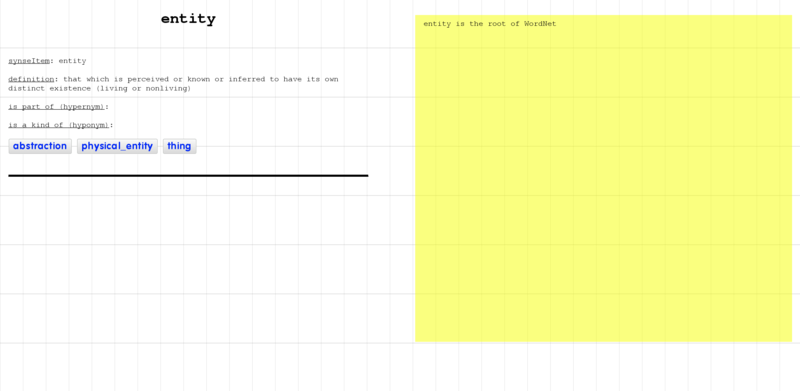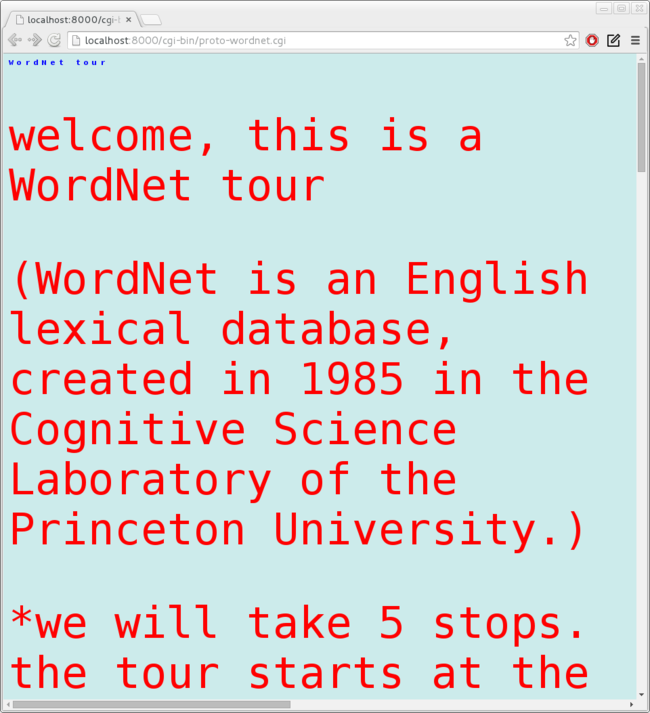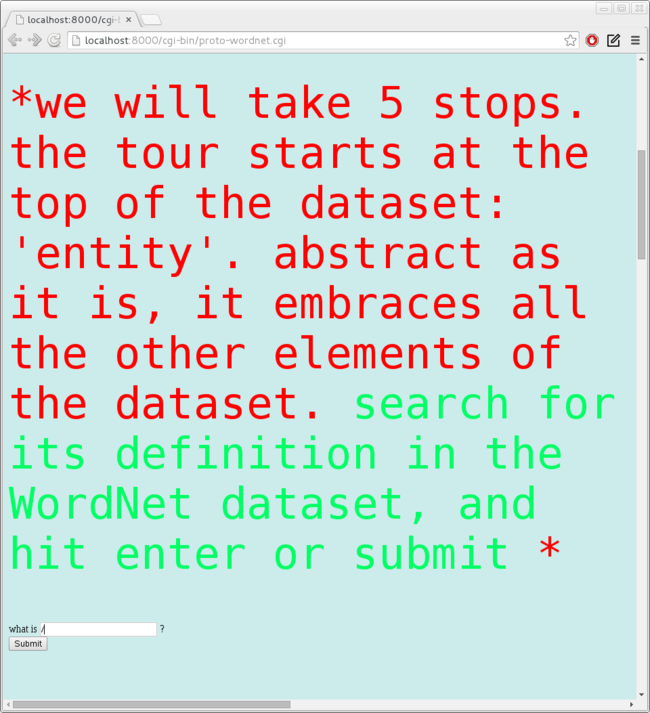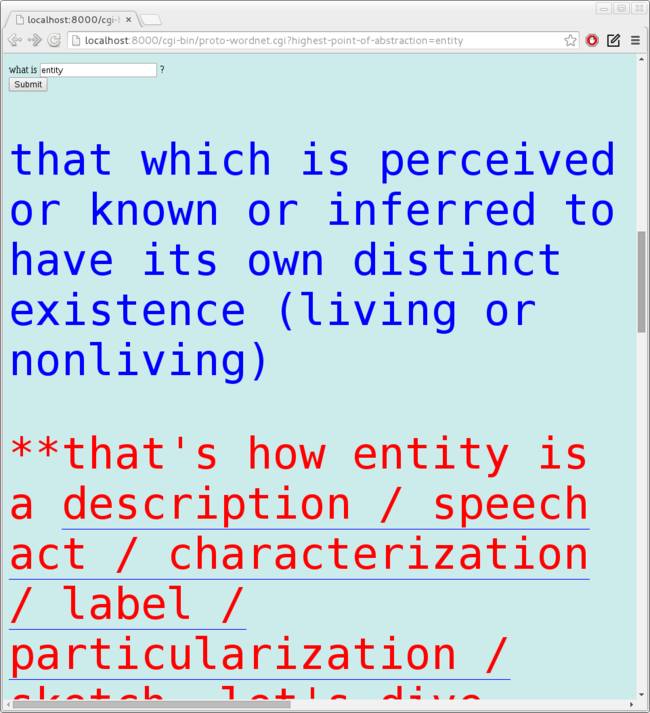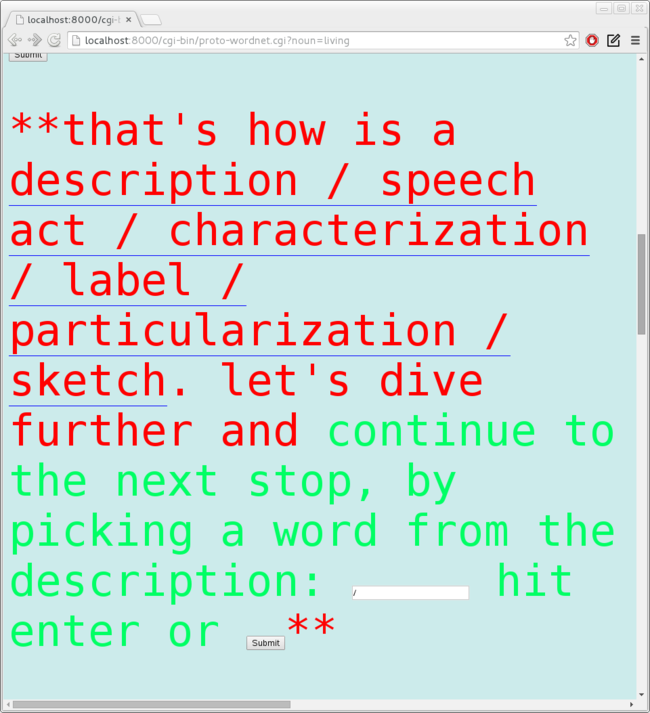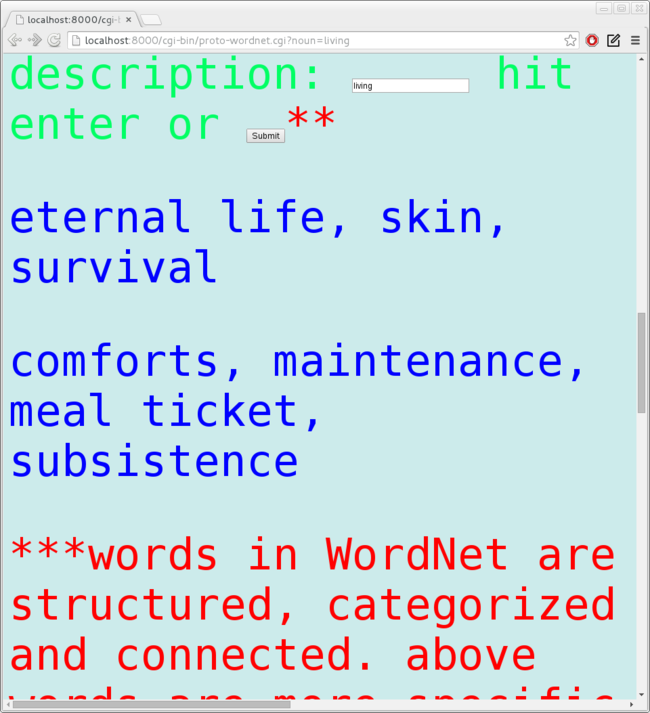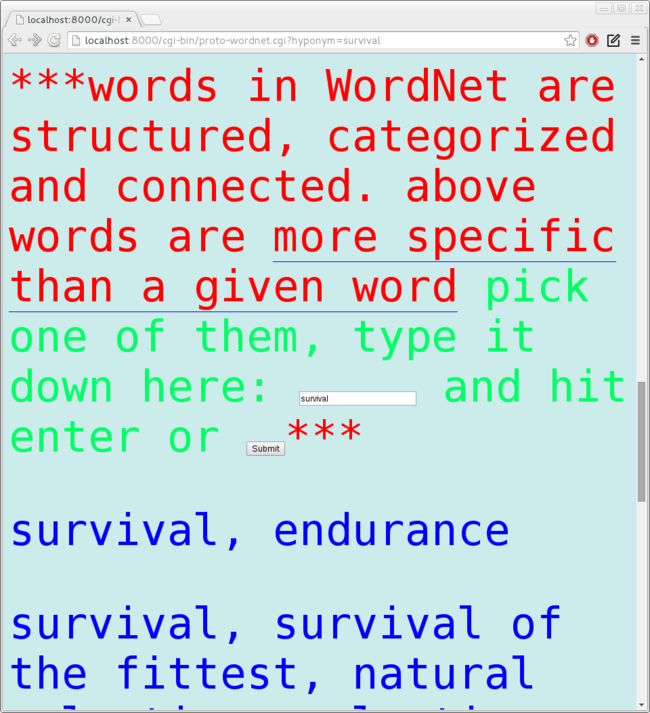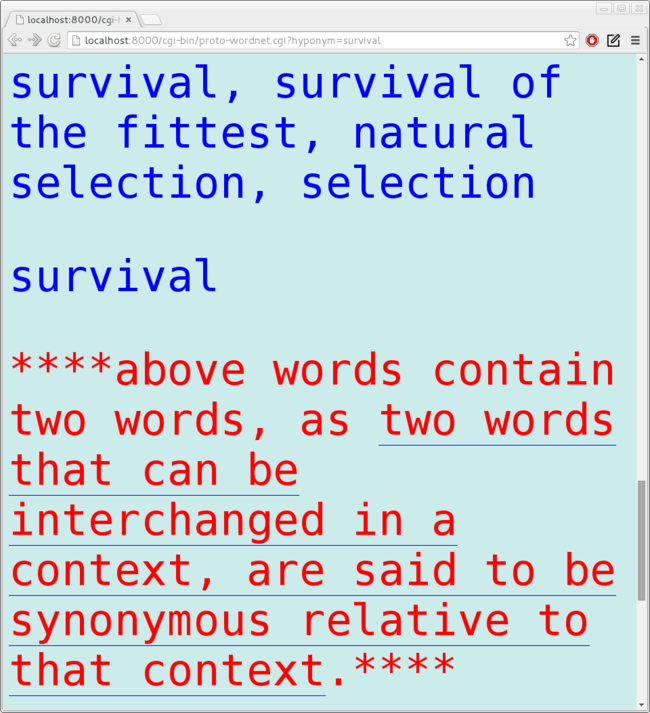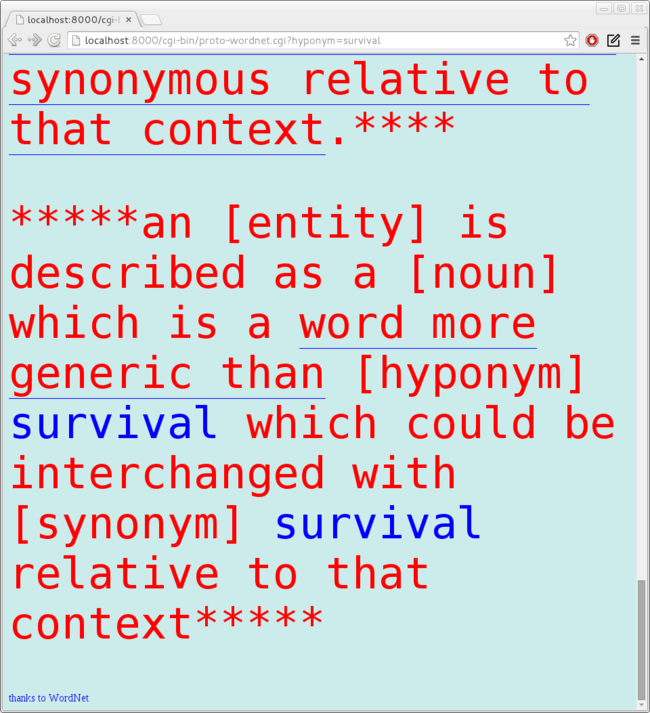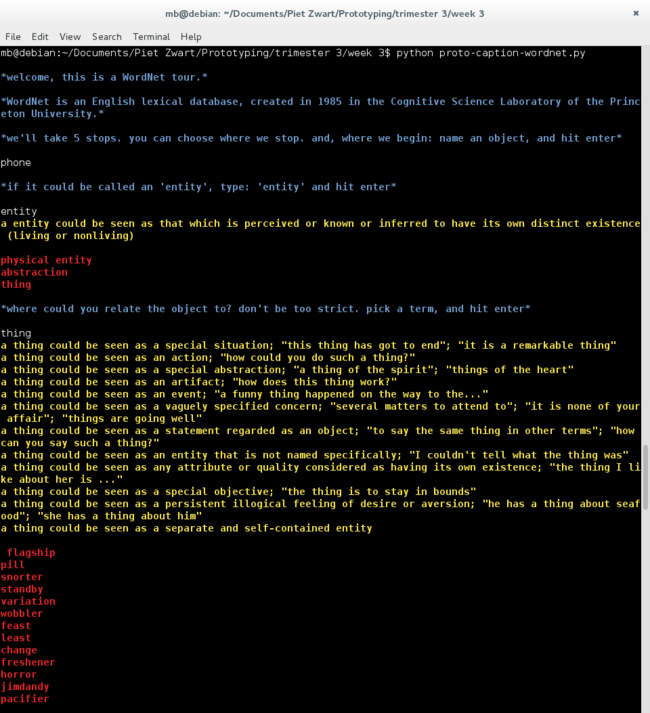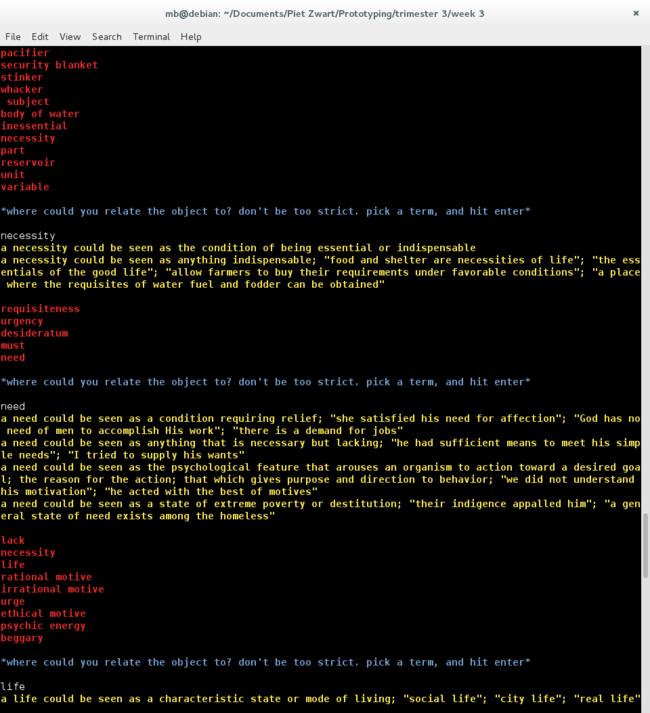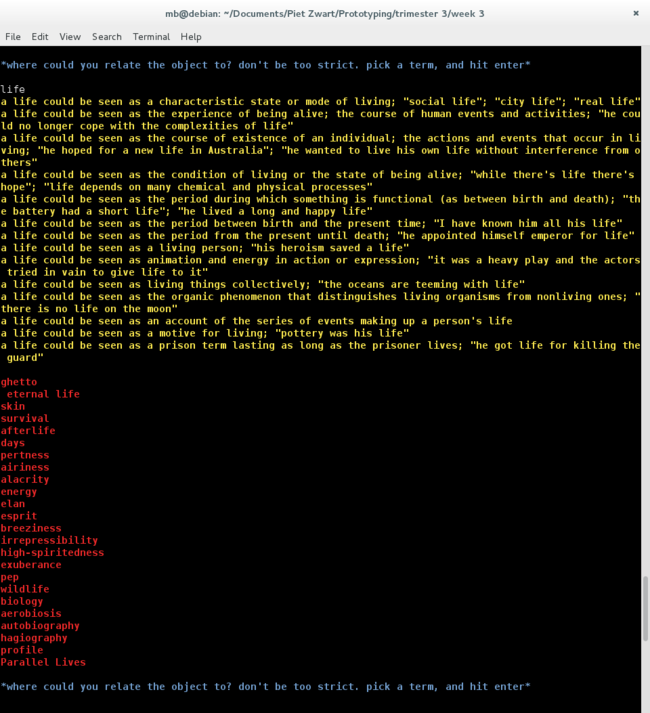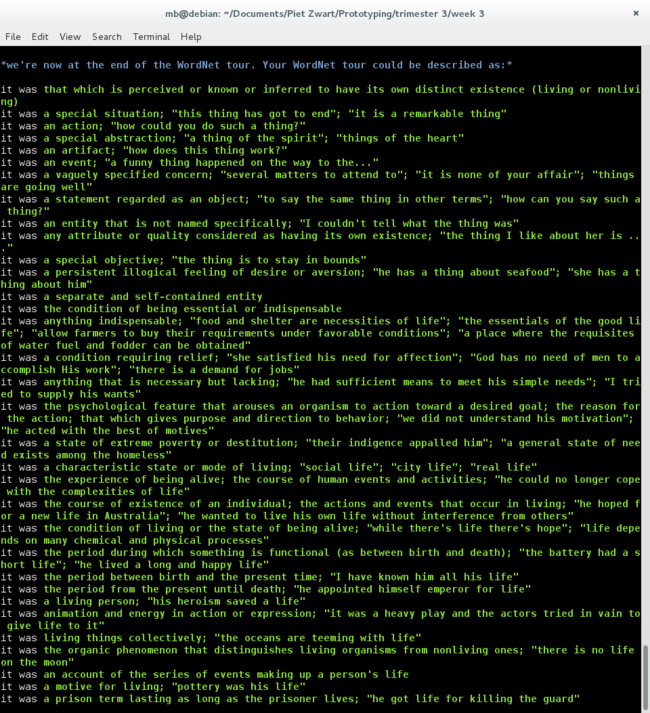User:Manetta/prototyping/conversational-interfaces-WordNet-tour
WordNet tour latest version
WordNet tour : hyponyms
This tour starts at the highest point in the WordNet lexicon: 'entity'. From there, the user can navigate through WordNet by clicking on the buttons. Each button contains the name of a hyponym, another synset from the lexicon that relates to the current. A hyponym-relation could be translated with 'is a kind of': it displays the synsets that are a kind of the current synset. When clicking at one of the buttons, the page will display the information (incl. a set of hyponyms) of that hyponym. In this way, the user navigates 'down' into WordNet, and will bump into moments where there is no deeper layer to click at.
WordNet tour : definitions
This tour starts as well at the root point of WordNet: 'entity', but this time the button's don't contain hyponyms, but rather every word from the displayed definition. From there, the user can navigate through WordNet, by clicking on words that are part of the definition. The user enters the recursive loops of definitions.
source code of this version
#!/usr/bin/python
import sys, cgi, re
import cgitb; cgitb.enable()
from nltk.corpus import wordnet as wn
from itertools import islice
input = cgi.FieldStorage()
word = input.getvalue("word","entity")
# reading from the URL (like argv is reading from the command line)
# --> http://url.org/read.cgi?line=1000
# '1' above is the default value
print "Content-type: text/html; charset=utf-8"
# needs to be the first line, as this is saying to the browser how to write
print
# empty line to end the header
print '<head>'
print '<link rel="stylesheet" type="text/css" href="../stylesheet.css">'
print '</head>'
print'''
<body>
<div id="wrapper">
<div id="left">
'''
if word:
print "<h1>"+word+"</h1>"
synsetList = []
synsets = wn.synsets(word)
for synset in synsets:
synsetList.append(synset)
for synsetItem in synsetList:
synset = str(synsetItem)
synset = re.sub(r"\..*\.\d\d.[)]", "", synset).replace('Synset(\'','')
print '<br /><br /><b>synseItem</b>:', synset
definition = synsetItem.definition()
print '<br /><br /><b>definition</b>:', definition
hypernym = str(synsetItem.hypernyms())
hypernym = re.sub(r"\..*\.\d\d.[)]", "", hypernym).replace('Synset(\'','').replace("[","").replace("]","")
print '<br /><br /><b>is part of (hypernym)</b>:', hypernym
print '<br /><br /><b>is a kind of (hyponym)</b>:<br /><br />'
hyponyms = synsetItem.hyponyms()
for hyponym in hyponyms:
hyponym = str(hyponym)
hyponym = re.sub(r"\..*\.\d\d.[)]", "", hyponym).replace('Synset(\'','')
print '''
<div class="button">
<form action= "">
<input type="submit" name="word" value={0} />
</form>
</div>
'''.format(hyponym)
print '<hr>'
print '''
<div id="right">
'''
entity = 'entity'
if word == entity:
print 'entity is the root of WordNet'
abstraction = 'abstraction'
if word == abstraction:
print 'abstraction is 33% of being entity'
'''
</div>
</div>
</div>
</body>
'''
WordNet tour version 2
using cgi and python -m CGIHTTPServer to display the script in the browser
screenshots
source code
#!/usr/bin/env python
from pattern.en import wordnet
import sys, os, re
import time
import cgi
import cgitb; cgitb.enable()
# Common Gateway Interface (CGI) is a standard method used to generate dynamic content on Web pages and Web applications. CGI, when implemented on a Web server, provides an interface between the Web server and programs that generate the Web content. These programs are known as CGI scripts or simply CGIs; they are usually written in a scripting language, but can be written in any programming language.
# --> CGI is an interface between webcontent & webserver !
# CGI extends this system by allowing the owner of the Web server to designate a directory within the document collection as containing ***executable scripts*** (or binary files) instead of pre-written pages; this is known as a CGI directory.
# forwarding a URL to a executable script
# anything that the script sends to standard output is passed to the Web client instead of being shown on-screen in a terminal window.
print 'Content-type:text/html'
print
print '<h1>WordNet tour</h1>'
print '<link rel="stylesheet" href="../stylesheet.css">'
print '<p>welcome, this is a WordNet tour</p>'
print '<p>(WordNet is an English lexical database, created in 1985 in the Cognitive Science Laboratory of the Princeton University.)</p>'
print '<p>*we will take 5 stops. the tour starts at the top of the dataset: \'entity\'. abstract as it is, it embraces all the other elements of the dataset. <em>search for its definition in the WordNet dataset, and hit enter or submit</em> *</p>'
line = cgi.FieldStorage()
s = line.getvalue("highest-point-of-abstraction","")
print '''<form action= "">
what is <input type="text" name="highest-point-of-abstraction" value={0} /> ?<br>
<input type="submit">
</form>'''.format(s)
try:
# print s
synset = wordnet.synsets(s)
# print synset
for i in range(len(synset)):
w = synset[i]
definition = w.gloss
print '<p><i>'+definition+'<i></p>'
except ValueError:
print ''
line = cgi.FieldStorage()
noun = line.getvalue("noun","")
print '''<form action= "">
<p>**that\'s how '''+s+''' is a <u>description / speech act / characterization / label / particularization / sketch</u>. let\'s dive further and <em>continue to the next stop, by picking a word from the description: <input type="text" name="noun" value={0} /> hit enter or <input type="submit"></em>**</p>
</form>'''.format(noun)
try:
# print s
synset = wordnet.synsets(noun)
# print synset
for i in range(len(synset)):
w = synset[i]
hyponyms = w.hyponyms()
hyponyms = str(hyponyms).strip("[]").replace("[","").replace("],","").replace("Synset(u'","").replace("')","")
print '<p><i>'+hyponyms+'<i></p>'
except ValueError:
print ''
line = cgi.FieldStorage()
hyponym = line.getvalue("hyponym","")
print '''<form action= "">
<p>***words in WordNet are structured, categorized and connected. above words are <u> more specific than a given word</u> <em>pick one of them, type it down here: <input type="text" name="hyponym" value={0} /> and hit enter or <input type="submit"></em>***</p>
</form>'''.format(hyponym)
try:
# print s
synset = wordnet.synsets(hyponym)
# print synset
for i in range(len(synset)):
w = synset[i]
synonym = w.synonyms
synonym = str(synonym).strip("[]").replace("[","").replace("u'","").replace("',",",").replace("'","")
print '<p><i>'+synonym+'<i></p>'
except ValueError:
print ''
line = cgi.FieldStorage()
entity = line.getvalue("entity","")
print '''<form action= "">
<p>****above words contain two words, as <u>two words that can be interchanged in a context, are said to be synonymous relative to that context</u>.****</p>
</form>'''.format(entity)
try:
print '<p>*****an [entity] <i>'+s+'</i> is described as a [noun] <i>'+noun+'</i> which is a <u>word more generic than</u> [hyponym] <i>'+hyponym+'</i> which could be interchanged with [synonym] <i>'+synonym+'</i> relative to that context*****</p>'
except ValueError:
print ''
print 'thanks to WordNet'
WordNet tour version 1
screenshots
source code
from pattern.en import wordnet
import sys, os, re
import time
from terminal_text_color import TextColor
tc = TextColor()
print tc.bold_blue("\n*welcome, this is a WordNet tour.*\n")
time.sleep(0)
print tc.bold_blue("*WordNet is an English lexical database, created in 1985 in the Cognitive Science Laboratory of the Princeton University.*\n")
time.sleep(0)
print tc.bold_blue("*we'll take 5 stops. you can choose where we stop. and, where we begin: name an object, and hit enter*\n")
objectname = sys.stdin.readline()
# objectname = objectname.replace("\n", "")
print tc.bold_blue("\n*if it could be called an 'entity', type: 'entity' and hit enter*\n")
definitions = []
for i in range (5):
line = sys.stdin.readline()
# readline --> reads line by line
# read --> reads entire file
line = line.replace("\n", "")
# print line
synset = wordnet.synsets(line)
categoriesLower = []
for i in range(len(synset)):
# print i
s = synset[i]
# print s
# print 'Definition:', s.gloss
# print ' Synonyms:', s.synonyms, '\n'
# print ' Hypernyms:', s.hypernyms(), '\n'
# print ' Hyponyms:', categoryLower
# print ' Holonyms:', s.holonyms(), '\n'
# print ' Meronyms:', s.meronyms(), '\n'
categoryLower = s.hyponyms()
categoriesLower.append(categoryLower)
definition = s.gloss
print tc.bold_yellow('a '+line+' could be seen as '+definition)
definitions.extend([definition])
categoriesLower = str(categoriesLower).strip("[]").replace("[","").replace("],","").replace("\')","\n").replace("\'","")
categoriesLower = categoriesLower.replace("Synset(u", "").replace(",,","").replace(" "," ").replace(", ","").replace("\n ","\n")
print tc.bold_red("\n"+categoriesLower)
print tc.bold_blue("*where could you relate the object to? don't be too strict. pick a term, and hit enter*\n")
print tc.bold_blue("*we're now at the end of the WordNet tour. Your WordNet tour could be described as:*\n")
listlen = len(definitions)
for i in range(len(definitions)):
d = definitions[i]
print 'it was', tc.bold_green(d)
# reference: 20 questions game, that names a object after 20 questions
# barend: maybe make it more
# WordNet makes a lot of quite bold statements, when you search for 'women' or 'man', interesting way of looking at such 'objective' dataset

